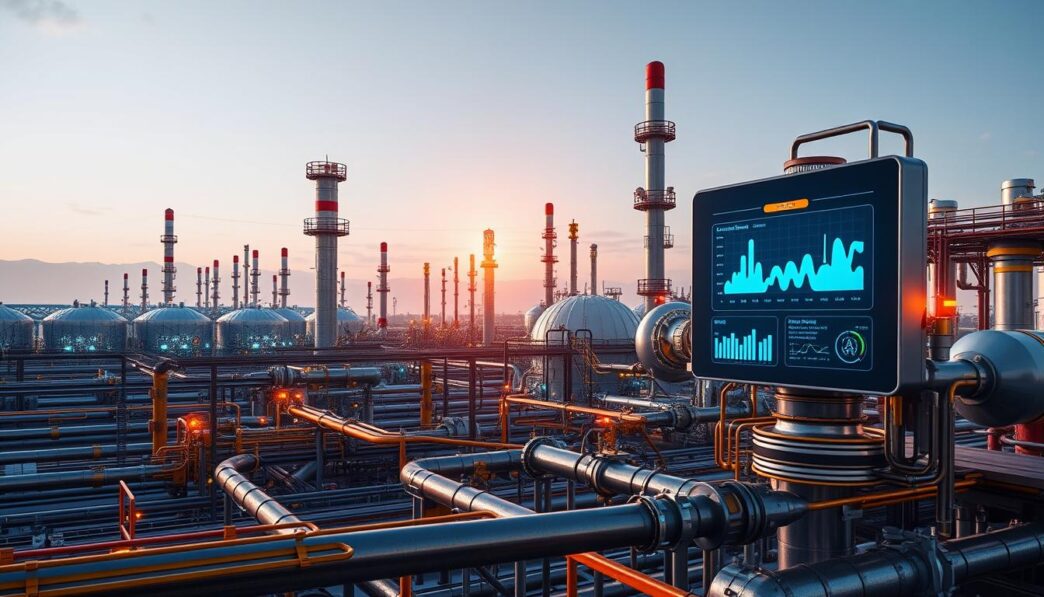Picture a world where unexpected equipment failures in huge oil refineries are history. Artificial intelligence (AI) here doesn’t just foresee problems but also stops them in their tracks. For Shell, this isn’t the future; it’s now. The industry saw nearly $6.9 billion spent on predictive maintenance in 2021. That’s expected to jump to $28.2 billion by 20261. This significant increase mirrors Shell’s smart use of AI for top-notch performance and safety at oil refineries.
Shell’s leading AI system, C3 AI, keeps an eye on over 10,000 key pieces of equipment. It acts as a shield against a massive $8 million loss that could happen from just 12 hours of unexpected shutdowns1. Indeed, the benefits of using AI in this field are vast. This technology changes Shell’s maintenance from a wait-and-fix mode to a plan-and-prevent strategy. This way, predictive maintenance becomes a key protector of operations.
Looking into how C3 AI works might seem daunting, but the idea is straight forward. It acts like a guardian with an amazing ability to forecast. It watches the data from over 3 million sensors. Every week, it sifts through more than 20 billion lines of data. It runs around 11,000 machine-learning models and makes over 15 million predictions. Its goal is to foresee and stop equipment failures1. This is how Shell makes the most out of AI: turning complex data into clear, lifesaving tips.
Shell’s AI-driven method has many benefits. It uses machine learning to foresee maintenance needs and prevent equipment breakdowns. This approach is all about sophisticated data handling and analysis. It gives maintenance teams precise guidance, like having a digital helper in the field. This advanced system works with the accuracy of a skilled expert but with endless energy2. To learn more about predictive maintenance and AI’s impact on Shell and more, check out The Benefits of Predictive Maintenance.
Key Takeaways:
- Shell leads in using AI for predictive maintenance, keeping critical refinery assets safe.
- AI significantly lowers unplanned downtimes and their huge costs, by early spotting equipment wear and tear.
- Predictive maintenance markets are on the rise, expected to grow from $6.9 billion to $28.2 billion by 20261.
- Shell’s AI setup is a model of excellence in machine learning, analyzing billions of data bits for daily predictions1.
- Shell’s move to AI-guided maintenance marks a new chapter in oil refinery safety, efficiency, and eco-friendliness.
Embracing AI for Predictive Maintenance in Energy Sector
The rise of AI in oil and gas is changing how companies like Shell do things. They’re using predictive maintenance to make operations more efficient and manage assets better. This change is crucial in an industry where small advancements can lead to big benefits and improve safety.
Shell’s use of AI technologies has improved the way it predicts and prevents equipment failure. This cuts down unplanned stops and keeps production going. By using smart algorithms and learning machines, Shell looks at lots of data to foresee equipment issues before they happen. This helps them fix things only when needed, saving money3.
Using AI tech proactively keeps operations running smoothly and makes important machinery last longer. This approach is key to Shell’s digital innovation strategy, making everything more efficient. For example, the reliability of control valves in Shell’s refineries has gotten much better thanks to this tech3.
The demand for AI in oil and gas is growing fast, expected to hit a big mark by 2034. This growth is because the technology helps the industry be more efficient and competitive4. Currently, more than 92% of oil and gas companies are planning to use AI. This shows that the industry agrees on the importance of digital change for long-lasting business5.
Shell and C3 AI working together is a great example of this trend. They’re aiming to make Shell’s operations around the world more reliable. They want to lower operation costs and help with the energy change3. This teamwork shows a big step towards using new technology to face today’s energy challenges. It also highlights how important Shell digital innovation is right now.
Using AI for predictive maintenance shows how digital tech can forecast equipment issues, use resources wisely, improve safety, and cut the risk of surprises. These improvements lead to a safer and more efficient way of working in the oil and gas field. It shows how crucial tech know-how is to tackle modern energy challenges.
How Shell Uses AI to Predict Equipment Failures in Oil Refineries
Shell leads in the energy sector by using AI predictive algorithms. These enhance Shell equipment monitoring for better safety and efficiency. With innovative sensor technology and AI data processing, Shell is creating new standards in oil and refineries.
The Significance of AI in Shell’s Equipment Monitoring
Shell focuses on excellence and safety with AI-driven diagnostics. The analytics spot issues early, avoiding unexpected equipment failures and ensuring safety6. Shell’s adoption of Bently Nevada’s digital monitoring system showcases its proactive maintenance strategy via AI6.
Data Processing: From Sensor Data to Actionable Insights
Gathering refinery operational data and turning it into helpful insights is complicated but interesting. Shell gathers lots of data with modern sensors. This data is then processed by AI to find valuable insights, suggesting how to boost efficiency67.
Machine Learning and Analytics in Predictive Maintenance
At Shell’s core of predictive maintenance are advanced machine learning models. They use old and new data to spot health patterns in equipment. These models get better over time, making maintenance more efficient and limiting operational issues67. Moreover, Shell’s use of machine learning and data analytics significantly improves safety and efficiency in its operations6.
| Technology | Function | Impact |
|---|---|---|
| AI Predictive Analytics | Equipment failure prediction | Prevents downtime, enhances safety |
| Machine Learning | Pattern recognition in operational data | Improves predictive accuracy, reduces disruptions |
| Sensor Technology | Real-time data acquisition | Enables data-driven decision making |

Shell mixes AI tools and technology to meet current energy demands and lead the future. This moves the industry towards more green and effective practices78.
Improving Safety and Efficiency in Refining Operations
The oil and gas industry has seen big changes in safety and AI efficiency. These improvements are not just daily practices but are backed by strong stats.
AI-powered predictive maintenance is a big win for safety. It changes how companies keep equipment safe, by predicting problems early. This means real-time safety checks improve and accidents decrease9.
The AI market in this sector is expected to grow a lot. It’s predicted to jump from $3.14 billion to $5.7 billion between 2024 and 2029910. AI’s role in making work safer and more efficient drives this growth.
Smart sensors at oil and gas sites are key for maintenance. They watch over things like sound and temperature to prevent equipment failure. This adds to safety9. AI also helps in understanding reservoir behavior better, avoiding problems10.
Over 92% of companies in the industry are investing in AI. This shows its importance in making operations safer and more efficient9. Big names like ExxonMobil and Chevron are already seeing benefits from AI for training and maintenance911.
| Company | AI Implementation Benefits | Reduction in Downtime | Maintenance Cost Reduction |
|---|---|---|---|
| Shell | Predictive Maintenance | 36% | 20% |
| BP | Predictive Maintenance Offshore Drilling | 50% | Significant Savings |
| Chevron | Predictive Maintenance for Rotating Equipment | Noticeable Improvement | 30% |
AI’s role in making operations safer and keeping maintenance on track is clear. It shows a way to more secure and efficient work in oil and gas11.
Commercialization and Global Impact of AI Predictive Solutions
Advancements in AI have greatly changed industries worldwide, especially in energy. The Open Energy AI Initiative shows this impact clearly. With Shell using the Shell C3 AI Suite, AI in oil and gas is moving beyond old ways. This marks a big step toward digital innovation and sustainability.
The Open Energy AI Initiative: Expanding AI’s Reach in Energy
The Open Energy AI Initiative proves the power of smart AI partnerships. It aims for a smarter, more efficient energy world. By pushing AI in the energy sector, the initiative spurs innovation and stresses the need for AI solutions that work together. This tackles big industry problems.
Partnerships with giants like Microsoft and Baker Hughes have made AI technologies more scalable. This broadens AI’s global influence. Through a team effort including C3 AI and Shell, the initiative explores new uses for AI in energy management.
Shell’s Strategic Partnership with AI Innovators
Shell’s work with C3 AI is a big step in using AI in business, focusing on making Shell’s digital solutions better. Since June 2021, this partnership has made Shell more efficient. They’ve seen fewer downtimes thanks to AI’s help in maintenance.
This partnership pushes Shell forward in digital twin technology and AI. It boosts their use of predictive AI and machine learning12.
The Broader Use Cases of Predictive AI in the Oil and Gas Industry
Predictive AI does a lot in oil and gas, more than just fix equipment. Shell’s AI for LNG production cuts emissions and boosts production. This shows how AI improves asset integrity and production.
Using AI in many areas, from planning to renewable energy, Shell boosts efficiency. This also helps the environment in the energy sector12.

Generative AI plays a key role, making sense of complex data. It also improves safety with digital twins of physical assets. This AI analytics also boosts compliance and efficiency, reducing the environmental impact of oil work13.
The role of AI in oil and gas is on a promising path thanks to initiatives like the Open Energy AI Initiative. Shell’s use of the Shell C3 AI Suite and other tools is leading to big changes. The future of AI in energy looks significant and critical for progress.
Conclusion
Shell is using artificial intelligence (AI) in oil refineries, showing AI’s big role in energy. AI is expected to grow to $4.21 billion by 2028, with a steady growth rate of 12.09%14. This shows AI is more than just a trend; it’s changing how things work, making operations better. Shell is leading in AI for maintenance, helping keep things safe and running smoothly148.
Shell’s AI helps predict when machines will need fixing. It uses smart algorithms to look at data from sensors. This can spot issues before they happen. Think of AI as a detective that finds tiny hints in huge data piles. It tells when a machine might break down. This technology sees things we can’t, letting Shell fix things before they actually break. This cuts down on surprise repairs and saves money8.
AI does more than just watch over machines. It helps the oil and gas industry handle changing markets and make the supply chain better. This makes work safer and more productive. These advancements are big steps toward a future that’s safer and greener. Shell and similar companies are leading the way. They use AI not just to keep up but to set new standards for the energy world148.




















